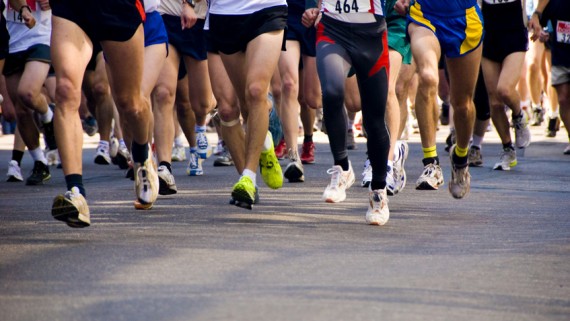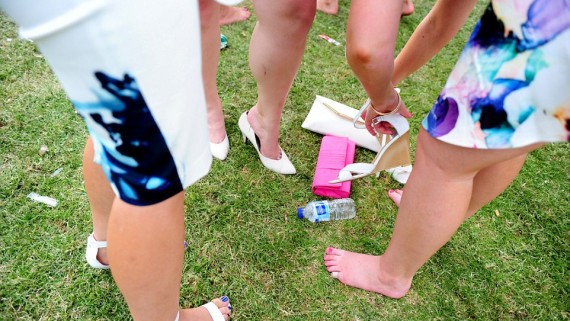Melbourne Marathon Podiatry Tips
At The Podiatry Group we are often asked for our top tips when training for a marathon. With the Melbourne Marathon coming up we have decided to give you a little insight to some helpful guidelines to consider when training and running in a marathon. The internet can provide a whole text book of information from how to carb load before an event to the best anti chafing stick to use. We will let you in on the best advice we provide for runner’s feet during their marathon.
- Get your runners professionally fitted. There are stores like Active Feet who are highly trained to fit running shoes. They can observe your running and walking patterns on a treadmill to better assess which shoe is most appropriate for you. Remember that runners will only last on average between 600-800kms so if you have been training hard make sure that by the time you reach your marathon day, your shoes still have life in them. If you are considering purchasing a new pair of shoes before your marathon, make sure that you have enough time to wear them in slowly before the big day. This means that you should have them at least 2 weeks before your event and begin wearing them in at home for a few hours and gradually progressing to a walk then a run. If you are purchasing the same brand and style as your last shoe make sure you speak with the person selling you your shoes to see if there have been any significant changes between the last and latest model. Sometimes the heel height (heel pitch) of a shoe will reduce or increase compared to the forefoot. This may alter the way that you run and impact the style of running you have trained for. At The Podiatry Group we are able to help assess your runners and ensure they are the right shoe for your running style and technique.
- Make sure you have the right socks. This may seem a silly statement; some of you may think that all socks are equal. We are here to tell you that they are not. There are socks that are designed to help prevent blistering. A small blister might not seem too daunting, but over a 42km run it can slowly but surely cause you more discomfort then you could imagine. There are socks that are specifically designed to wick moisture away from the feet leaving them dry. Some brands that are able to do this are Thorlo, Wigwam and Injinji.
- Make sure your nails are cut! Cut your nails before an event but leave 1mm of nail growth at the end (1mm of the white part of the nail), this will ensure you don’t cut the too short and bleed causing a bit of a mess and some sore toes before you even begin running. This will also help minimise the risk of your nails going black from bruising or even losing your nails after a marathon. Sometimes our nails get blackened or fall off after an event like a marathon from repetitive micro-trauma. This can be where our toes hit the end of our shoes when running causing micro damage to the nail. This can also be due to our shoes not being laced properly.
- Get rid of that build up of hard skin! If you have callous on your feet then odds are you have a lot of pressure and friction occurring at that site. If you would like this professionally removed then contact us. If you only have a small amount and think you can manage yourself then the best way is to use a pumice stone. A pumice stone must be used wet (in the bath or shower), it is best used if you rub the pumice stone on a cake of soap and then on the hardened skin until you have taken enough off.
- Compression stockings can help aid recovery time. It has been shown that an average persons calf will expand in diameter after standing for 1-3 hours. As such, you can imagine that when running a marathon (which could take anywhere between 3-5 hours depending on your speed) your calf will expand and could cause discomfort and a feeling of fatigue. We recommend that all runners consider compression stockings. Please note that we strongly advise that a runner come in for an assessment before using a high grade compression stocking.
- Have fun! You may choose to run a marathon only once in your life or you may be crazy enough to run many times. Our most important tip we could give you is to enjoy it. You’ve worked so hard to get to where you are, all those training sessions, all that blood sweat and tears, just don’t forget to enjoy yourself.
If you are training for a marathon and want to speak with one of our Podiatrists then you can contact us. We have Podiatry Clinics located in Cranbourne, Drouin and Warragul.
Sore Feet at the races
With Spring Carnival Racing just around the corner we have decided to let you in on our closest secrets to keeping your feet looking and more importantly feeling fabulous at the races. Don’t put up with sore feet anymore.
Women all over Victoria will be flooding the shops looking for fabulous fascinators, cute clutches and horrendously high heels. We will give you the inside scoop on what to look for when it comes to footwear at the races and how to prevent those dreaded sore feet. We understand the perils of looking good at the races, a little bit of discomfort is expected but we want to make sure you aren’t hobbling home on feet filled with blisters, swelling and bruising.
After a day in those beautiful strappy heels you can be faced with a very difficult decision; To walk home crippled, feeling intense pain and burning with every step or to take the shoes off and face the risk of contracting something terrible from the sticky alcohol smeared ground?
We offer you a new option! Be prepared and follow our tips to be leaving the races with your head held high, your footwear on and hopefully with a pocket full of cash from all of your winning horses.
What shoes should I wear?
When it comes to picking a shoe that you will be spending all day walking and standing in it is important to take comfort into account. After all, we can’t spend all day sitting around, ordering our friends to place our bets, serve us drinks and shade us from the sun! To avoid sore feet don’t pick the highest stiletto with as many straps to rival a salsa dancer. Think a little more conservatively. A wider heel helps distribute force over a larger area, meaning less pain. You could also look for a heel that has a platform at the front of the shoe. This way you can look like your wearing 6 inch heels without your toes constantly slipping to the front of your shoe.
A wedge is also a great shoe to consider for Spring Racing, No one ever sunk into soft grass in a wedge! (Our motto is “No woman left behind!”) If you pick a shoe that is a similar shape to your foot you will be amazed with the comfort this will offer. Some shoes have really pointy ends and will cause your toes to be squished. Although this may look great they are better saved for a dinner date where you can be sitting most of the time.
Another consideration to make is how is your foot going to stay inside your shoe? This may seem a silly question to ask but as women, we know all to well that in certain footwear our heels can slip out of the back. This may be okay the first few times but after the 499th time it can get a little old- Not to mention cause enough friction to start a fire at the back of our heel! A strap at the front of the shoe will ensure our foot stays in place. Less movement of our foot inside the shoes means less friction and therefore less likelihood of blisters. You will also spend less time clawing at your shoes to keep them on when walking- you would be surprised with how tiring this can be.
When it comes to picking what material the shoe is made out of, natural is always best. Leather is a great material that will mould to the shape of your foot with repeated wear. This means that if you “break in your shoes” properly before the big day you will have already altered the shape of the outside of the shoe to help it fit better. We always recommend to wear your shoes for a few hours at a time in the weeks leading up to a big event. It’s like a marathon- if you don’t put in the training ladies you will regret it on the day! The only leather we advise to be cautious with it patent leather. The name may be a little misleading, it doesn’t have the same feel as leather as it has been coated which makes it stiff and unforgiving. This means it will not mould well to your feet and will be about as sore on the day as when you are breaking them in.
Stockings are a great option to consider too! They help prevent your feet from rubbing inside the shoe. They come in a range of colours to match your natural skin colour and they can even prevent you from having to fake tan. The stocking has evolved from what we remember our grandmas wearing when we were young. They even have the peep toe variety so you can wear them in open toe shoes and not have to worry about a seam showing. Stockings also apply pressure around our legs and ankles; this can help stop swelling when we have spent all day standing. Something that will be greatly appreciated at the end of the day.
The Podiatry Group have sourced some great looking and comfortable footwear brands that you can be confident will provide you with the support and comfort needed to face a day at the Spring Races.
Bared Footwear is a great brand that has many heels, wedges and flats with arch support built in. The reason these are so fabulous and comfortable is that a female Melbourne podiatrist has designed them and understands exactly the fine line between fashion and comfort.
Ziera is another brand that provide great quality shoes with built in arch supports.
Visiting your podiatrist before the races is a great way to ensure your feet are looking fabulous and fresh. You don’t want cracked heels or discoloured nails stopping you from wearing open shoes. That’s where we can help. Come visit our Podiatrists at Cranbourne, Drouin or Warragul.
Remember to keep all the above tips in mind when considering your footwear at the races.
From the friendly team at TPG.


